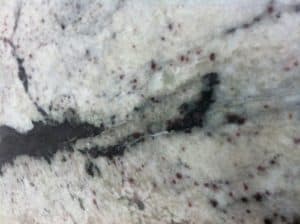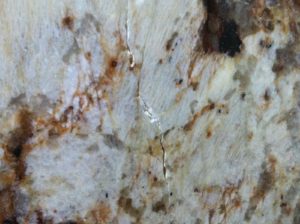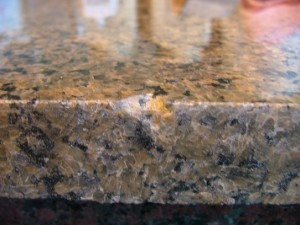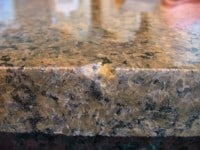Let’s begin with the process of explaining the steps to repairing your countertops. Firstly, it is important to understand whether the crack you are observing is an actual crack or a fissure, for chips you can skip to the repair section of this post. This information is relevant when determining which type of materials are required to get the job done right.
Fissures Vs. Cracks. Which are which?
Fissures are naturally occurring in many types of stone. Defined by the American Geological Institute as an “extensive Crack, break, or fracture in the rock..”, the term is used in the stone industry to describe a visible separation along the crystalline boundaries naturally occurring in the stone. More often than not a fissure does not go through the entire depth of the stone, although in some cases it can.

Photo Courtesy of naturalstoneoutlet.blogspot.com

Photo Courtesy of naturalstoneoutlet.blogspot.com
Cracks on the other hand result from stresses from handling, fabrication, transport, and/or installation. While a crack by definition does not necessarily go through the entire depth of the stone, this is more commonly seen than a fissure going through the entire depth of the stone.
How do I know if it’s a fissure or a crack and why does it matter?
Cracks will often appear around areas of stress – such as the where the countertop opens up for the sink. Cracks are notorious for popping up in areas such as these – fissures, being naturally occurring are not prone to “mysteriously” appearing near the kitchen sink.
Cracks also tend to show up on and around supports and typically follow a more or less straight line. Fissures can appear straight as well, although remember that they are occurring along the natural crystalline structure of the stone, and are not induced by installation.
Another thing to keep in mind is that the fissures you might see on a commercially installed countertop are going to be very narrow; you shouldn’t be able to lose a key in it; a crack on the other hand could potentially be wide enough for that.
How else can I tell if it’s a fissure or a crack?
Since a fissure is a naturally occurring it doesn’t change the plane of the stone. That is, if you placed a level across the fissure, it would remain flush with both sides of the stone. Also, fissures often occur in more than one place whereas a crack may just appear in a place of added stress.
Another way to tell if it’s a fissure or a crack is to run your fingernail or a car key across it. If it’s smooth, it’s more likely a fissure. If it is rough and “catches” your nail or car key, you might have a crack on your hands.
Repairing your Stone
Fissure and Chip Repairs: You want to use a clear resin, epoxy, or acrylic adhesive for repairing small cracks and fissures. In the Countertop Stone Repair section of our store you will find recommended products such as Lamlock Infiltrating Epoxy, LiquiGlass, and Tenax Tefill Kit. If you’re looking for a complete solution for fixing chips in granite, check out our Granite & Marble chip and crack repair kit.

Photo Courtesy of naturalstoneoutlet.blogspot.com
LiquiGlass is a fast-setting clear epoxy which dries very hard and clear (rather like glass), hence its name. It is both permanent and UV stable, and under normal circumstances will dry in about one minute.
The next is Tenax Tefill kit. This is a great product that comes in a complete kit with everything you need to fix small holes and chips in stone. This kit comes with two viscosities of resin and along with a spray-on catalyst to dry the resin. The manufacturer recommends using the high viscosity fluid to repair larger chips, especially those that are not on a horizontal surface (the higher viscosity fluid isn’t as prone to running as lower viscosity fluids), and using the lower viscosity fluid to repair cracks, fissures, scratches, and/or chips which are on a horizontal surface.
After spraying the resin with the catalyst and allowing it to dry, take a razor blade and scrape off the excess from the surface. Unlike LiquiGlass, the Tefill Kit is neither permanent glue nor is it considered UV stable; there is some history of this product discoloring certain stone colors, so it is recommended that you test it in an inconspicuous place a few days prior to making your repairs.
Finally, Pectro, which is a resin based color enhancer can be used to fill voids, and can help to enhance lighter shades found in cracks and fissures to help them to match the polished surface of the stone.
Note: these products are for minor repairs only, and should not be used for any structural bonding whatsoever.
What About Cracks in Stone Specifically?
We have found that when fixing cracks, a low viscosity epoxy works best as it does a great job of penetrating deep into the crack and forming a bond. This also has the added benefit of helping to prevent the crack from growing larger, although that can’t be guaranteed. A great product we recommend for this is Lamlock Infiltrating Epoxy. Once you’ve repaired the crack in this manner, some of the products mentioned above, or a polyester resin color matched to your stone can help to make the countertop look like-new. We have many colors such as green, black, yellow, red, brown, blue, white, grey, and more. You can find these products in our Store.
What about Breaks?
In our experience, an epoxy is best for repairing breaks, and our favorite is Lamlock RocketGel – Instant Epoxy. This epoxy was specifically formulated for granite and other natural stone products. This epoxy helps to bind the broken joints in the stone together, and after the 25 minutes, we think you’d have a tough time breaking the joint, even with a hammer and a chisel. Another great benefit to this epoxy is that it doesn’t like to stick to polished surfaces; making for an easy cleanup. Transparent in thin coats, cloudy white in layers to 1/8” and off-white in thicker layers when fully cured, which occurs within 24 hours. Furthermore, this epoxy is not climate sensitive, so whether you live in an arid climate or a humid one, this epoxy will be minimally impacted by the weather; it cures equally fast in hot or cold temperatures. Also, this epoxy can be mixed with countertop coloring tints to ensure a seamless repair.
Now that you know the difference between a chip, a crack, and a fissure, but don’t want to repair it yourself, feel free to fill out our form; you’ll get contacted by top notch contractors in your area for a free quote!
